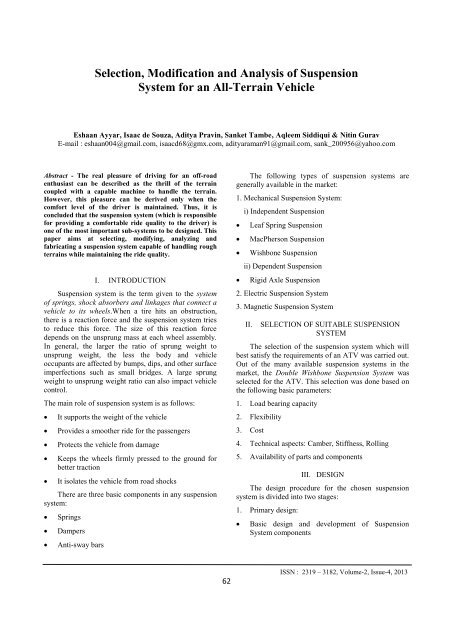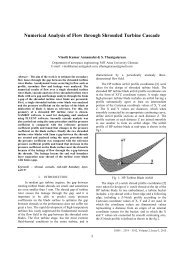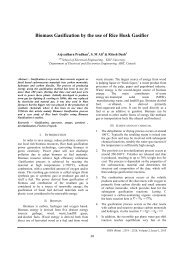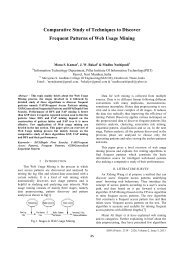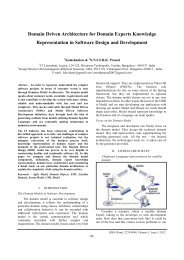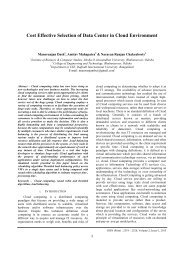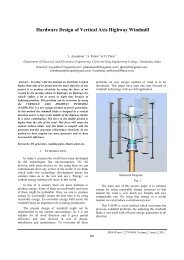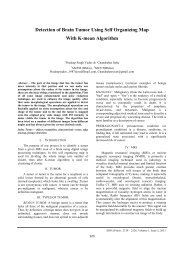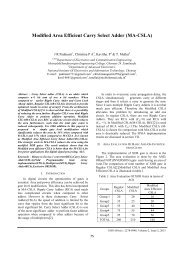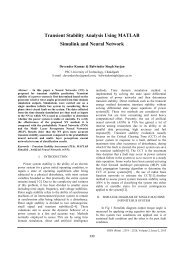Selection, Modification and Analysis of Suspension ... - IRD India
Selection, Modification and Analysis of Suspension ... - IRD India
Selection, Modification and Analysis of Suspension ... - IRD India
Create successful ePaper yourself
Turn your PDF publications into a flip-book with our unique Google optimized e-Paper software.
<strong>Selection</strong>, <strong>Modification</strong> <strong>and</strong> <strong>Analysis</strong> <strong>of</strong> <strong>Suspension</strong>System for an All-Terrain VehicleEshaan Ayyar, Isaac de Souza, Aditya Pravin, Sanket Tambe, Aqleem Siddiqui & Nitin GuravE-mail : eshaan004@gmail.com, isaacd68@gmx.com, adityaraman91@gmail.com, sank_200956@yahoo.comAbstract - The real pleasure <strong>of</strong> driving for an <strong>of</strong>f-roadenthusiast can be described as the thrill <strong>of</strong> the terraincoupled with a capable machine to h<strong>and</strong>le the terrain.However, this pleasure can be derived only when thecomfort level <strong>of</strong> the driver is maintained. Thus, it isconcluded that the suspension system (which is responsiblefor providing a comfortable ride quality to the driver) isone <strong>of</strong> the most important sub-systems to be designed. Thispaper aims at selecting, modifying, analyzing <strong>and</strong>fabricating a suspension system capable <strong>of</strong> h<strong>and</strong>ling roughterrains while maintaining the ride quality.I. INTRODUCTION<strong>Suspension</strong> system is the term given to the system<strong>of</strong> springs, shock absorbers <strong>and</strong> linkages that connect avehicle to its wheels.When a tire hits an obstruction,there is a reaction force <strong>and</strong> the suspension system triesto reduce this force. The size <strong>of</strong> this reaction forcedepends on the unsprung mass at each wheel assembly.In general, the larger the ratio <strong>of</strong> sprung weight tounsprung weight, the less the body <strong>and</strong> vehicleoccupants are affected by bumps, dips, <strong>and</strong> other surfaceimperfections such as small bridges. A large sprungweight to unsprung weight ratio can also impact vehiclecontrol.The main role <strong>of</strong> suspension system is as follows:It supports the weight <strong>of</strong> the vehicleProvides a smoother ride for the passengersProtects the vehicle from damageKeeps the wheels firmly pressed to the ground forbetter tractionIt isolates the vehicle from road shocksThere are three basic components in any suspensionsystem:SpringsDampersAnti-sway barsThe following types <strong>of</strong> suspension systems aregenerally available in the market:1. Mechanical <strong>Suspension</strong> System:i) Independent <strong>Suspension</strong>Leaf Spring <strong>Suspension</strong>MacPherson <strong>Suspension</strong>Wishbone <strong>Suspension</strong>ii) Dependent <strong>Suspension</strong>Rigid Axle <strong>Suspension</strong>2. Electric <strong>Suspension</strong> System3. Magnetic <strong>Suspension</strong> SystemII.SELECTION OF SUITABLE SUSPENSIONSYSTEMThe selection <strong>of</strong> the suspension system which willbest satisfy the requirements <strong>of</strong> an ATV was carried out.Out <strong>of</strong> the many available suspension systems in themarket, the Double Wishbone <strong>Suspension</strong> System wasselected for the ATV. This selection was done based onthe following basic parameters:1. Load bearing capacity2. Flexibility3. Cost4. Technical aspects: Camber, Stiffness, Rolling5. Availability <strong>of</strong> parts <strong>and</strong> componentsIII. DESIGNThe design procedure for the chosen suspensionsystem is divided into two stages:1. Primary design:Basic design <strong>and</strong> development <strong>of</strong> <strong>Suspension</strong>System components62ISSN : 2319 – 3182, Volume-2, Issue-4, 2013
International Journal on Theoretical <strong>and</strong> Applied Research in Mechanical Engineering (IJTARME) Modified design parameters based onapproximation <strong>of</strong> Dynamic ConditionsStatic testing <strong>and</strong> analysis2. Secondary design:Mathematical modeling <strong>of</strong> finalized concept ATVDynamic testing <strong>and</strong> analysis<strong>Modification</strong> <strong>of</strong> Design Parameters based onDynamic Testing resultsThe following components are to be designed:<strong>Suspension</strong> SpringWishbonesKnuckleDesign procedure for the components <strong>of</strong> <strong>Suspension</strong>system is dependent on the suspension geometry (asshown in Fig.1 <strong>and</strong> Fig.2); found out by taking intoconsiderations the design constraints. According to the mass distribution <strong>of</strong> 60:40 (Rear:Front)Mass per wheel (Front) = 50 kgMass per wheel (Rear) = 80 kg1) Front springAngle <strong>of</strong> inclination <strong>of</strong> the strut = 60 (from horizontal)Point <strong>of</strong> attachment <strong>of</strong> strut = 10” (254 cm) from chassisend ….(from suspension geometry)Reaction force acting from the ground on the wheel =(Mass per wheel * 9.81) N= (50 kg * 9.81) N= 490.5 NFig.1 Front suspension geometryFig.2 Rear suspension geometryDesign <strong>of</strong> suspension springAssumptions made: Sprung mass = 260 kg(approx.) Factor for static to dynamic conditions : 2.5Fig.3. Forces on front wishboneConsidering the wishbone hinges as the point aboutwhich moment is taken;Horizontal distance <strong>of</strong> reaction force from hinge point= 17.36” (44.09 cm) ….from suspensiongeometryHorizontal distance <strong>of</strong> strut attachment point from hingepoint = 8.2” (20.828 cm)By taking moment about hinge points :490.5 * 17.36 = Spring Force * 8.23 Spring Force = 1034.6 NConsidering the dynamic factor,Dynamic force acting on the spring = 2586.59 NAccording to the ride conditions <strong>and</strong> road quality for anATV, it is concluded that the optimum spring travelshould be approx. 4” (10.16 cm)Hence, Required Spring StiffnessDynamic Spring Force=Spring Deflection= 25.46 N /mm=2586 .59101.663ISSN : 2319 – 3182, Volume-2, Issue-4, 2013
International Journal on Theoretical <strong>and</strong> Applied Research in Mechanical Engineering (IJTARME)25 N/mm2) Rear springAngle <strong>of</strong> inclination <strong>of</strong> the strut = 80 o (from horizontal)Point <strong>of</strong> attachment <strong>of</strong> strut = 6.5” (16.51 cm) fromchassis end…(from suspension geometry)Reaction force acting from the ground on the wheel= (Mass per wheel * 9.81) N= (80 kg * 9.81) NFig.4. Forces on rear wishboneConsidering the wishbone hinges as the point aboutwhich moment is taken;Horizontal distance <strong>of</strong> reaction force from hinge point =14” (35.56 cm) …..(from suspension geometry)Horizontal distance <strong>of</strong> strut attachment point from hingepoint = 6.38” (16.02 cm)By taking moment about hinge points :784.8 * 14 = Spring Force * 6.38 Spring Force = 1722.13 NConsidering the dynamic factor,Dynamic force acting on the spring = 4305.325 NAccording to the ride conditions <strong>and</strong> road quality for anATV, it is concluded that the optimum spring travelshould be approx. 4” (10.16 cm)Hence, Required Spring Stiffness= =Table 1. Spring dimensionsSr.No.ParameterFront<strong>Suspension</strong>Rear<strong>Suspension</strong>Material Grade 4 oil hardened spring steel1 Wire diameter 11 mm 11 mm2 Inner coil 55 mm 55 mmdiameter3 Outer coil 66 mm 66 mmdiameter4 Total number 22 14<strong>of</strong> turns5 Free length <strong>of</strong> 365 mm 292 mmstrut6 Pitch <strong>of</strong> 18 mm 27 mmsuspensionspring7 Eye-to-eye 456 mm 484 mmlength <strong>of</strong> strut(unloaded)8 Stiffness 25 N/mm 40 N/mm9 Maximumdynamic springtravelB. Design <strong>of</strong> wishbones101.12 mm 100.88 mmThe design parameters that govern the dimensions <strong>of</strong> thewishbone are :i) Available length for wishbones: 32 inchesii) Available width for wishbones: 20 inches1) Front wishboneThe front wishbones are st<strong>and</strong>ard A-arms <strong>and</strong> thedimensions are decided on the basis <strong>of</strong> the length <strong>and</strong>width constrains (as shown in Fig.5). The wishboneshave unequal length.The upper wishbone is shorter thanthe lower wishbone.The advantage <strong>of</strong> having differentlengths is that when the car takes a turn a negativecamber is induced which increases the stability.Theunequal lengths also result in a positive camber <strong>of</strong>1.5⁰.The strut is mounted on the lower wishbone <strong>and</strong> theknuckle is attched to the wishbone by a ball joint. Thewishbone is then tested using Autodesk Inventor.40 N/mm= 42.375 N64ISSN : 2319 – 3182, Volume-2, Issue-4, 2013
International Journal on Theoretical <strong>and</strong> Applied Research in Mechanical Engineering (IJTARME)2) Rear wishboneFig.5.Front WishboneInitially, the A-arm was considered for the rearsuspension. However, while the vehicle takes a turn, dueto the horizontal forces acting on the attachments <strong>of</strong> thewishbones <strong>and</strong> the knuckle <strong>and</strong> due to lack <strong>of</strong> steeringon the rear wheels, there may be toe-in or toe-out <strong>of</strong> thewheels. This may lead to improper steering <strong>and</strong> mayresult in unbalance. Excess toe-in may cause oversteerwhile turning leading to loss <strong>of</strong> control. Excess toe-outmay cause understeering while turning.To avoid anytoeing, the A-arm is converted into H-arm (as shown inFig.6). Thus the vertical pin knuckle-wishboneattachment is converted into horizontal pin attachment.This prevents formation <strong>of</strong> an axis <strong>and</strong> hence thepossibility <strong>of</strong> toeing <strong>of</strong> the wheels. This ensures properalignment <strong>and</strong> steering. It also increases the ride stability<strong>and</strong> linear travel.Fig.7.Front KnuckleDue to lack <strong>of</strong> funds the above design could not bemanufactured.The knuckle <strong>of</strong> a maruti 800 wasmodified so that it could accmmodate the designedwishbones.The modified design is shown below.Fig.8.Modified Front Knuckle2) Rear knuckleThe rear knuckle was designed to accommodate thedesigned H-arms (Fig.9)C. Design <strong>of</strong> knuckleFig.6.Rear WishboneA knuckle is used to connect the wishbones to thewheel hub.1) Front knuckleThe first step in the design was market research. Ast<strong>and</strong>ard knuckle <strong>of</strong> MARUTI SUZUKI ESTEEM wasselected from the market <strong>and</strong> studied. The suspensionsystem <strong>of</strong> the Esteem is MacPherson type, hence theknuckle had to be modified. The designed knuckle isshown. (Fig.7)Fig.9.Rear Knuckle65ISSN : 2319 – 3182, Volume-2, Issue-4, 2013
International Journal on Theoretical <strong>and</strong> Applied Research in Mechanical Engineering (IJTARME)The rear knuckle too could not be manufactured due tolack <strong>of</strong> funds.the knuckle <strong>of</strong> an esteem was modified asshown in the figureThe rear upper wishbone was tested as the strutattachment point was on the upper wishbone. The hingeswere considered as fixed points <strong>and</strong> a load <strong>of</strong> 4305.325N was applied at the strut attachment point.Fig.10.Modified Rear KnuckleTESTING OF DESIGNED COMPONENTS<strong>Analysis</strong> <strong>of</strong> all the parts was done using Autodeskinventor.WishbonesThe front lower wishbone was tested as the strut isattached on the lower wishbone due to which most <strong>of</strong>the load acts on the lower wishbone. The wishbone wastested on Autodesk inventor. The two hinge points <strong>and</strong>ball joint were considered as fixed points <strong>and</strong> a load <strong>of</strong>2586.59 N(load on spring) was applied at the strutattchment point.Load applied: 4305.325 NFactor <strong>of</strong> safety: 1.5Result: Design is safeB. KnucklesFig.12.Rear WishboneThe hub end <strong>of</strong> the knuckle was considered fixed<strong>and</strong> a load <strong>of</strong> 2586.95 N was applied at the lower part <strong>of</strong>the knuckle as shown in fig.13.Fig.11.Front WishboneLoad applied: 2586.59 NFactor <strong>of</strong> safety: 1.5Result: Design is safeLoad applied: 2586.59 NFactor <strong>of</strong> safety = 3.5Result: Design is safeFig.13.Testing <strong>of</strong> front knuckleThe attchment for the front knuckle was tested <strong>and</strong> theresult (Fig 14).66ISSN : 2319 – 3182, Volume-2, Issue-4, 2013
International Journal on Theoretical <strong>and</strong> Applied Research in Mechanical Engineering (IJTARME)Load applied: 2586.59 NFactor <strong>of</strong> safety = 3.5Result: Design is safeFig.14.Testing <strong>of</strong> front knuckle attchmentThe rear knuckle was tested in a similar way.theresults are shown belowIV. FABRICATIONThe fabrication <strong>of</strong> all the parts was done in theworkshop.The final fabricated parts are shown below.Material used for wishbones: AISI 1026Dimensions <strong>of</strong> pipe: 19 mm ID, 3 mm thicknessMaterial used for all other fabrications <strong>and</strong>modifications:Mild Steel plates <strong>of</strong> thickness 4 mm <strong>and</strong> 8 mmLoad applied: 4305.325 NFig.15.Testing <strong>of</strong> rear knuckleResult: Design is safe (Factor <strong>of</strong> safety = 4)Fig.17.Fabricated front wishboneFig.16 Testing <strong>of</strong> modified rear knuckleFig.18.Fabricated rear wishbone67ISSN : 2319 – 3182, Volume-2, Issue-4, 2013
International Journal on Theoretical <strong>and</strong> Applied Research in Mechanical Engineering (IJTARME)Fig.19 Front knuckle with attachmentV. REFERENCES[1] Christina Elena Popa, ‘Steering System <strong>and</strong><strong>Suspension</strong> System’, University Of SouthQueensl<strong>and</strong>[2 ] Edmund F. Gaffney <strong>and</strong> Anthony R. Salinas,‘Introduction to Formula SAE <strong>Suspension</strong>’,University Of Missouri[3] Mitchell W., ‘Force based roll centres <strong>and</strong>kinematic roll centres’, SAE-<strong>India</strong>[4] Gertz L., L. Laranja, ‘An <strong>of</strong>f-road suspensionsystem’, University Of Brazil[5] Gerrard M., ‘Roll centres <strong>and</strong> jacking forces’,Engineering Solutions[6] NK Giri, ‘Automobile Mechanics’, KhannaPublications, 1996[7] Kirpal Singh, ‘Automobile Engineering’,St<strong>and</strong>ard Publishers Distributors, 2008[8] Thomas D.Gillespie, ‘Fundamentals <strong>of</strong> VehicleDynamics’[9] T.K. Garrett, K. Newton, W. Steeds, ‘The MotorVehicle’, Butterworth-Heinemann, 2000[10] Design Data Book, PSG Technology InstituteFig.20 Rear <strong>Suspension</strong>Fig 20. Final Assembly68ISSN : 2319 – 3182, Volume-2, Issue-4, 2013


